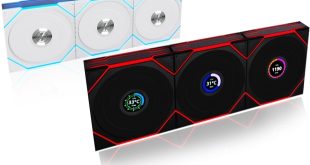Measuring in at 95 x 95 x 27mm and with a weight of 235g, the TC90LS heatsink's compressed design should allow it to fit in even the most confined environments.
Four sections of the P.A.T.S-coated aluminium fin array are removed at each corner to allow space for the mounting holes and screws.
Phanteks also uses its C.P.S.C, or Cold Plasma Spraying Coating, technology on the PH-TC90LS CPU cooler. According to the company, the coating can allow thermal energy to be transferred at an increased rate.
P.A.T.S (Physical Antioxidant Thermal Shield) is claimed by Phanteks as a coating technology that allows heat from external sources such as a graphics card or memory to be blocked, hence not allowing it to enter the CPU cooler's thermal system. Theoretically, this is a good idea and design choice, but we'll wait to see if the performance figures back-up that point.
A nickel-plated copper base transfers thermal energy from an LGA 115X or 2011 CPU's heatspreader to the PH-TC90LS cooler. The base is an almost-uniform piece of metal that features a 2.5mm protrusion which allows contact to be made with the CPU.
This type of design allows the entire base to act as a medium from which heat can be directly transferred to the fin array. It is similar to a heatpipe's function, but is more of a direct approach, although that's not to say its conduction rates are any better or worse than those of a ‘standard' heatpipe.
Despite its base design, the PH-TC90LS uses a pair of flattened heatpipes embedded in the base to transfer heat to the fin array's outer edges.
A pair of rubber strips is used to damp vibrations that are caused by the fan and prevent them from accessing the CPU cooler's metal structures. The strips are fastened to the cooler by pre-applied sticky tape.
Phanteks uses the same fan clip system that is present on its other CPU coolers, just this time it's smaller. The method requires plastic adapters to be pushed through the fan's mounting holes, before a metal fan clip is then slipped through the adapters' fastening slits.
The method takes some getting used to and has proven to be awkward to use on Phanteks' larger models. Now that it is being implemented on a low profile product, the fiddly procedure is made even trickier by slight interferences with the fan's frame.
Once connected, the clips are perfectly capable of securing the fan's weight.
With the 92 x 92 x 15mm PH-F90 fan attached, the PH-TC90LS CPU cooler's height is extended to 45mm. A channel cut into either side of the aluminium fin array provides a point that the fan clips can be secured to.
We are happy to see Phanteks using a sturdy metal backplate, despite this cooler's lightweight design. Extra support from a well-designed backplate is always a welcomed feature.
Four spring-loaded screws hold the low profile CPU cooler firmly in position.
When finally mounted, the PH-TC90LS CPU cooler's diminutive dimensions are evident. The only real area where interference could possibly occur would be from the 45mm height when very small cases are used or other components cause interference.
Mini-ITX motherboards that don't abide by Intel's ‘keep-out' zone around the CPU socket could also foul the cooler, but that's more of a motherboard issue.
 KitGuru KitGuru.net – Tech News | Hardware News | Hardware Reviews | IOS | Mobile | Gaming | Graphics Cards
KitGuru KitGuru.net – Tech News | Hardware News | Hardware Reviews | IOS | Mobile | Gaming | Graphics Cards










